Enhanced Removal of Malachite Green Using Calcium-Functionalized Magnetic Biochar
Abstract
:1. Introduction
2. Materials and Methods
2.1. Materials
2.2. Biochar Preparation and Modification
2.3. Batch Adsorption Experiments
2.3.1. Adsorption Kinetics and Isothermal Adsorption
2.3.2. Effect of Solution pH on the Adsorption Effect
2.3.3. Regeneration of Ca/MBC
2.4. Characterization
3. Results and Discussion
3.1. Characterization of Samples
3.2. Adsorption Study
3.2.1. Effect of MBC and Ca/MBC on MG Adsorption
3.2.2. Adsorption Kinetics and Isotherms
3.2.3. Effect of pH on Adsorption
3.2.4. Effect of Recycling
3.3. Adsorption Mechanisms
4. Conclusions
Supplementary Materials
Author Contributions
Funding
Institutional Review Board Statement
Informed Consent Statement
Data Availability Statement
Conflicts of Interest
References
- Kooravand, M.; Asadpour, S.; Haddadi, H.; Farhadian, S. An insight into the interaction between malachite green oxalate with human serum albumin: Molecular dynamic simulation and spectroscopic approaches. J. Hazard. Mater. 2020, 407, 124878. [Google Scholar] [CrossRef]
- Lu, J.; Zhou, Y.; Lei, J.; Ao, Z.M.; Zhou, Y. Fe3O4/graphene aerogels: A stable and efficient persulfate activator for the rapid degradation of malachite green. Chemosphere 2020, 251, 126402. [Google Scholar] [CrossRef]
- Renita, A.A.; Vardhan, K.H.; Kumar, P.S.; Ngueagni, P.T.; Abilarasu, A.; Nath, S.; Kumari, P.; Saravanan, R. Effective removal of malachite green dye from aqueous solution in hybrid system utilizing agricultural waste as particle electrodes. Chemosphere 2021, 273, 129634. [Google Scholar] [CrossRef]
- Aracier, E.D.; Urucu, O.A.; Akmaki, E. Imidazole modified acrylate-containing photocured hydrogels for the efficient removal of malachite green dye from aqueous solutions. J. Appl. Polymer Sci. 2021, 138, 51415. [Google Scholar] [CrossRef]
- Wei, W.; Pang, Y.; Lim, S.; Wong, K.H.; Lai, C.; Abdullah, A.Z. Enhancement of photocatalytic degradation of Malachite Green using iron doped titanium dioxide loaded on oil palm empty fruit bunch-derived activated carbon. Chemosphere 2021, 272, 129588. [Google Scholar] [CrossRef]
- Zhang, Q.; Cheng, T.; Lin, Q.; Fang, C. Facile preparation of robust dual MgO-loaded carbon foam as an efficient adsorbent for malachite green removal. Environ. Res. 2021, 195, 110698. [Google Scholar] [CrossRef]
- Gopinathan, R.; Kanhere, J.; Banerjee, J. Effect of malachite green toxicity on non target soil organisms. Chemosphere 2015, 120, 637–644. [Google Scholar] [CrossRef]
- Eric, V.; Melaine, B.; Marie-Pierre, C.; Pierrick, C.; Marie-Pierre, F.; Régine, F.; Murielle, G.; Sophie, G.; Dominique, H.-P.; Michel, L.; et al. The monitoring of triphenylmethane dyes in aquaculture products through the European union network of official control laboratories. J. AOAC Int. 2015, 98, 649–657. [Google Scholar] [CrossRef]
- Yao, X.; Ji, L.; Guo, J.; Ge, S.; Lu, W.; Chen, Y.; Cai, L.; Wang, Y.; Song, W. An abundant porous biochar material derived from wakame (Undaria pinnatifida) with high adsorption performance for three organic dyes. Bioresour. Technol. 2020, 318, 124082. [Google Scholar] [CrossRef]
- Yin, Y.; Li, C.; Song, C.; Tao, P.; Sun, M.; Pan, Z.; Wang, T.; Shao, M. The design of coal-based carbon membrane coupled with the electric field and its application on the treatment of malachite green (mg) aqueous solution. Colloid. Surf. A 2016, 506, 629–636. [Google Scholar] [CrossRef]
- Mu, J.; Wang, D.; Yang, G.; Cui, X.; Yang, Q. Preparation and characterization of a substitute for ruditapes philippinarum conglutination mud as a natural bioflocculant. Bioresour. Technol. 2019, 281, 480–484. [Google Scholar] [CrossRef]
- Yulizar, Y.; Apriandanu, D.; Ashna, R.I. La2CuO4-decorated ZnO nanoparticles with improved photocatalytic activity for malachite green degradation. Chem. Phys. Lett. 2020, 755, 137749. [Google Scholar] [CrossRef]
- Han, S.; Han, W.; Chen, J.; Sun, Y.; Zhao, G. Bioremediation of malachite green by cyanobacterium synechococcus elongatus PCC 7942 engineered with a triphenylmethane reductase gene. Appl. Microbiol. Biotechnol. 2020, 104, 3193–3204. [Google Scholar] [CrossRef]
- Cao, H.; Wu, X.; Syed-Hassan, S.; Zhang, S.; Mood, S.H.; Milan, Y.J.; Garcia-Perez, M. Characteristics and mechanisms of phosphorous adsorption by rape straw-derived biochar functionalized with calcium from eggshell. Bioresour. Technol. 2020, 318, 124063. [Google Scholar] [CrossRef]
- Murthy, T.P.K.; Gowrishankar, B.S.; Prabha, M.N.C.; Kruthi, M.; Krishna, R.H. Studies on batch adsorptive removal of malachite green from synthetic wastewater using acid treated coffee husk: Equilibrium, kinetics and thermodynamic studies. Microchem. J. 2019, 146, 192–201. [Google Scholar] [CrossRef]
- Wu, J.; Yang, J.; Feng, P.; Huang, G.; Xu, C.; Lin, B. High-efficiency removal of dyes from wastewater by fully recycling litchi peel biochar. Chemosphere 2020, 246, 125734. [Google Scholar] [CrossRef]
- Eltaweil, A.; Mohamed, H.A.; El-Monaem, E.; El-Subruiti, G.M. Mesoporous magnetic biochar composite for enhanced adsorption of malachite green dye: Characterization, adsorption kinetics, thermodynamics and isotherms. Adv. Powder Technol. 2020, 31, 1253–1263. [Google Scholar] [CrossRef]
- Mahanty, B.; Mondal, S. Synthesis of magnetic biochar using agricultural waste for the separation of Cr(VI) from aqueous solution. Arab J. Sci. Eng. 2021, 46, 10803–10818. [Google Scholar] [CrossRef]
- Agrafioti, E.; Kalderis, D.; Diamadopoulos, E. Arsenic and chromium removal from water using biochars derived from rice husk, organic solid wastes and sewage sludge. J. Environ. Manag. 2014, 133, 309–314. [Google Scholar] [CrossRef]
- Imran, M.; Iqbal, M.M.; Iqbal, J.; Shah, N.S.; Khan, Z.U.H.; Murtaza, B.; Amjad, M.; Ali, S.; Rizwan, M. Synthesis, characterization and application of novel MnO and CuO impregnated biochar composites to sequester arsenic (As) from water: Modeling, thermodynamics and reusability. J. Hazard. Mater. 2021, 401, 123338. [Google Scholar] [CrossRef]
- Wan, S.; Lin, J.; Tao, W.; Yang, Y.; Li, Y.; He, F. Enhanced fluoride removal from water by nanoporous biochar-supported magnesium oxide. Ind. Eng. Chem. Res. 2019, 58, 988–9996. [Google Scholar] [CrossRef]
- Su, C.; Wang, S.; Zhou, Z.; Wang, H.; Xie, X.; Yang, Y.; Feng, Y.; Liu, W.; Liu, P. Chemical processes of Cr(VI) removal by Fe-modified biochar under aerobic and anaerobic conditions and mechanism characterization under aerobic conditions using synchrotron-related techniques. Sci. Total Environ. 2021, 768, 144604. [Google Scholar] [CrossRef]
- Liu, J.; Cheng, W.; Yang, X.; Bao, Y. Modification of biochar with silicon by one-step sintering and understanding of adsorption mechanism on copper ions. Sci. Total Environ. 2019, 704, 135252. [Google Scholar] [CrossRef]
- Luo, M.; Lin, H.; He, Y.; Li, B.; Dong, Y.; Wang, L. Efficient simultaneous removal of cadmium and arsenic in aqueous solution by titanium-modified ultrasonic biochar. Bioresource Technol. 2019, 284, 333–339. [Google Scholar] [CrossRef]
- Xu, Y.; Qu, W.; Sun, B.; Peng, K.; Zhang, X.; Xu, J.; Gao, F.; Yan, Y.; Bai, T. Effects of added calcium-based additives on swine manure derived biochar characteristics and heavy metals immobilization. Waste Manag. 2021, 123, 69–79. [Google Scholar] [CrossRef]
- Zhang, P.; O’Connor, D.; Wang, Y.; Jiang, L.; Xia, T.; Wang, L.; Tsang, D.C.W.; Ok, Y.S.; Hou, D. A green biochar/iron oxide composite for methylene blue removal. J. Hazard. Mater. 2020, 384, 121286. [Google Scholar] [CrossRef]
- Choudhary, M.; Kumar, R.; Neogi, S. Activated biochar derived from Opuntia ficus-indica for the efficient adsorption of malachite green dye, Cu2+ and Ni2+ from water. J. Hazard. Mater. 2020, 392, 122441. [Google Scholar] [CrossRef]
- Sewu, D.D.; Lee, D.S.; Tran, H.N.; Woo, S.H. Effect of bentonite-mineral co-pyrolysis with macroalgae on physicochemical property and dye uptake capacity of bentonite/biochar composite. J. Taiwan Inst. Chem. Eng. 2019, 104, 106–113. [Google Scholar] [CrossRef]
- Chen, H.R.; Tsai, W.T.; Chou, T.C.; Tsai, C.Y.; Chang, Y.M.; Kuo, K.C. Novel Preparation of Bamboo Biochar and Its Application on Cationic Dye Removal. J. Biobased Mater. Bioenergy 2011, 5, 556–561. [Google Scholar] [CrossRef]
- Zazycki, M.A.; Borba, P.A.; Silva, R.N.F.; Peres, E.C.; Perondi, D.; Collazzo, G.C.; Dotto, G.L. Chitin derived biochar as an alternative adsorbent to treat colored effluents containing methyl violet dye. Adv. Powder Technol. 2019, 30, 1494–1503. [Google Scholar] [CrossRef]
- Lan, Y.; Wang, H.; Li, X.; Jin, S.; Zhang, Y. The Absorption of Kitchen Waste Mixed-base Biochar on Malachite Green. Chem. Lett. 2020, 49, 20–23. [Google Scholar] [CrossRef]
- Meili, L.; Godoy, R.P.S.; Soletti, J.I.; Carvalho, S.H.V.; Ribeiro, L.M.O.; Silva, M.G.C.; Vieira, M.G.A.; Gimenes, M.L. Cassava (Manihot esculenta Crantz) stump biochar: Physical/chemical characteristics and dye affinity. Chem. Eng. Commun. 2019, 206, 829–841. [Google Scholar] [CrossRef]
- Bharti, V.; Vikrant, K.; Goswami, M.; Tiwari, H.; Sonwani, R.K.; Lee, J.; Tsang, D.C.W.; Kim, K.H.; Saeed, M.; Kumar, S.; et al. Biodegradation of methylene blue dye in a batch and continuous mode using biochar as packing media. Environ. Res. 2019, 171, 356–364. [Google Scholar] [CrossRef]
- Saeed, A.A.H.; Harun, N.Y.; Sufian, S.; Siyal, A.A.; Zulfiqar, M.; Bilad, M.R.; Vagananthan, A.; Al-Fakih, A.; Ghaleb, A.A.S.; Almahbashi, N. Eucheuma cottonii Seaweed-Based Biochar for Adsorption of Methylene Blue Dye. Sustainability 2020, 12, 10318. [Google Scholar] [CrossRef]
- Gokulan, R.; Prabhu, G.G.; Jegan, J. Remediation of complex remazol effluent using biochar derived from green seaweed biomass. Int. J. Phytoremediat. 2019, 21, 1179–1189. [Google Scholar] [CrossRef]
- Chahinez, H.O.; Abdelkader, O.; Leila, Y.; Tran, H.N. One-stage preparation of palm petiole-derived biochar: Characterization and application for adsorption of crystal violet dye in water. Environ. Technol. Innov. 2020, 19, 14. [Google Scholar] [CrossRef]
- Amin, M.T.; Alazba, A.A.; Shafiq, M. Comparative study for adsorption of methylene blue dye on biochar derived from orange peel and banana biomass in aqueous solutions. Environ. Monit. Assess. 2019, 191, 14. [Google Scholar] [CrossRef]
- Seenuvasan, M.; Malar, C.G.; Carter, R.; Praveen, S. Magnetite embedded biochar as nano-sorbent for effective adsorption of textile dye. Latin Am. Appl. Res. 2021, 51, 185–192. [Google Scholar] [CrossRef]
- Jegan, J.; Praveen, S.; Kumar, B.M.; Pushpa, T.B.; Gokulan, R. Box-Behnken experimental design for the optimization of Basic Violet 03 dye removal by groundnut shell derived biochar. Desalin. Water Treat. 2021, 209, 379–391. [Google Scholar] [CrossRef]
- Saravanan, P.; Josephraj, J.; Thillainayagam, B.P.; Ravindiran, G. Evaluation of the adsorptive removal of cationic dyes by greening biochar derived from agricultural bio-waste of rice husk. Biomass. Convers. Bio. 2021, 3. [Google Scholar] [CrossRef]
- Wu, D.; Tian, S.; Long, J.; Peng, S.; Xu, L.; Sun, W.; Chu, H. Remarkable phosphate recovery from wastewater by a novel Ca/Fe composite: Synergistic effects of crystal structure and abundant oxygen-vacancies. Chemosphere 2020, 266, 12910. [Google Scholar] [CrossRef] [PubMed]
- Jing, L.; Fu, H.; Wang, B.; Wang, D.; Xin, B.; Li, S.; Sun, J. Effects of Sn dopant on the photoinduced charge property and photocatalytic activity of TiO2 nanoparticles. Appl. Catal. B Environ. 2006, 62, 282–291. [Google Scholar] [CrossRef]
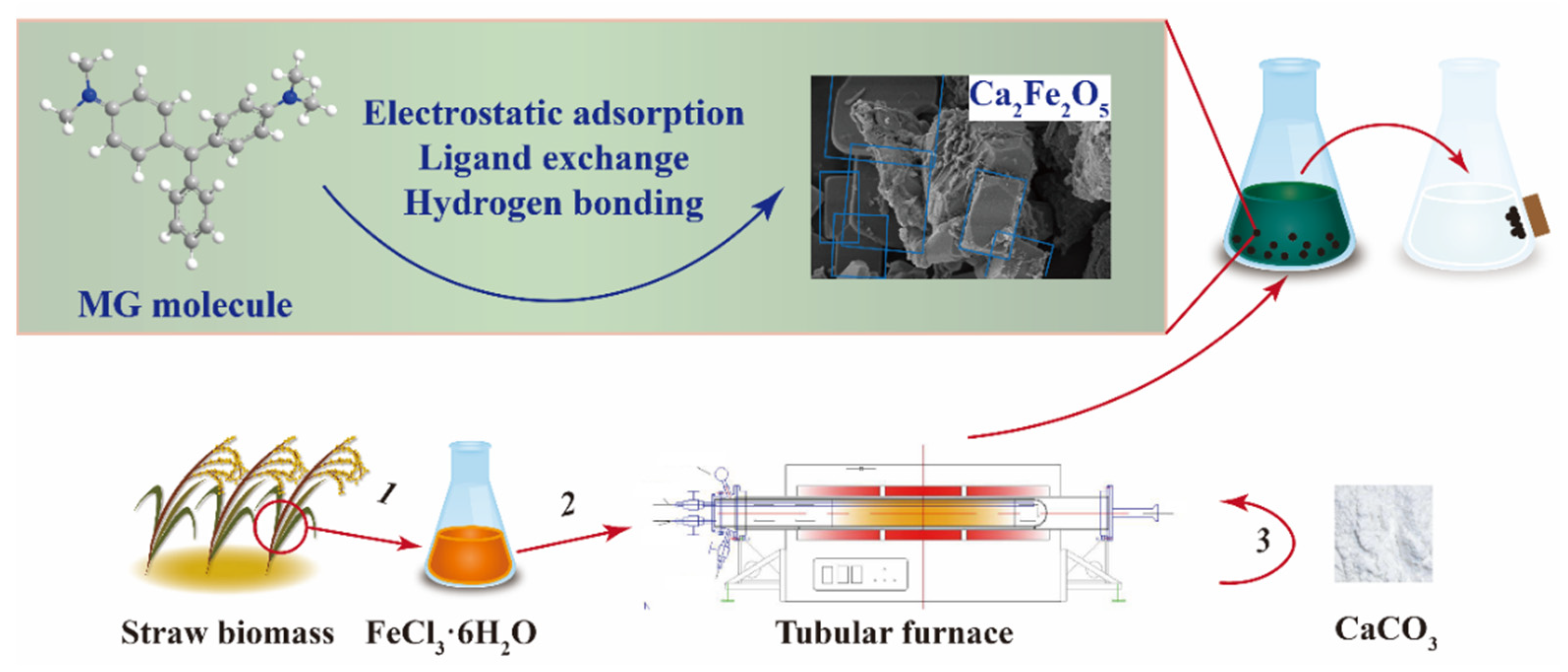
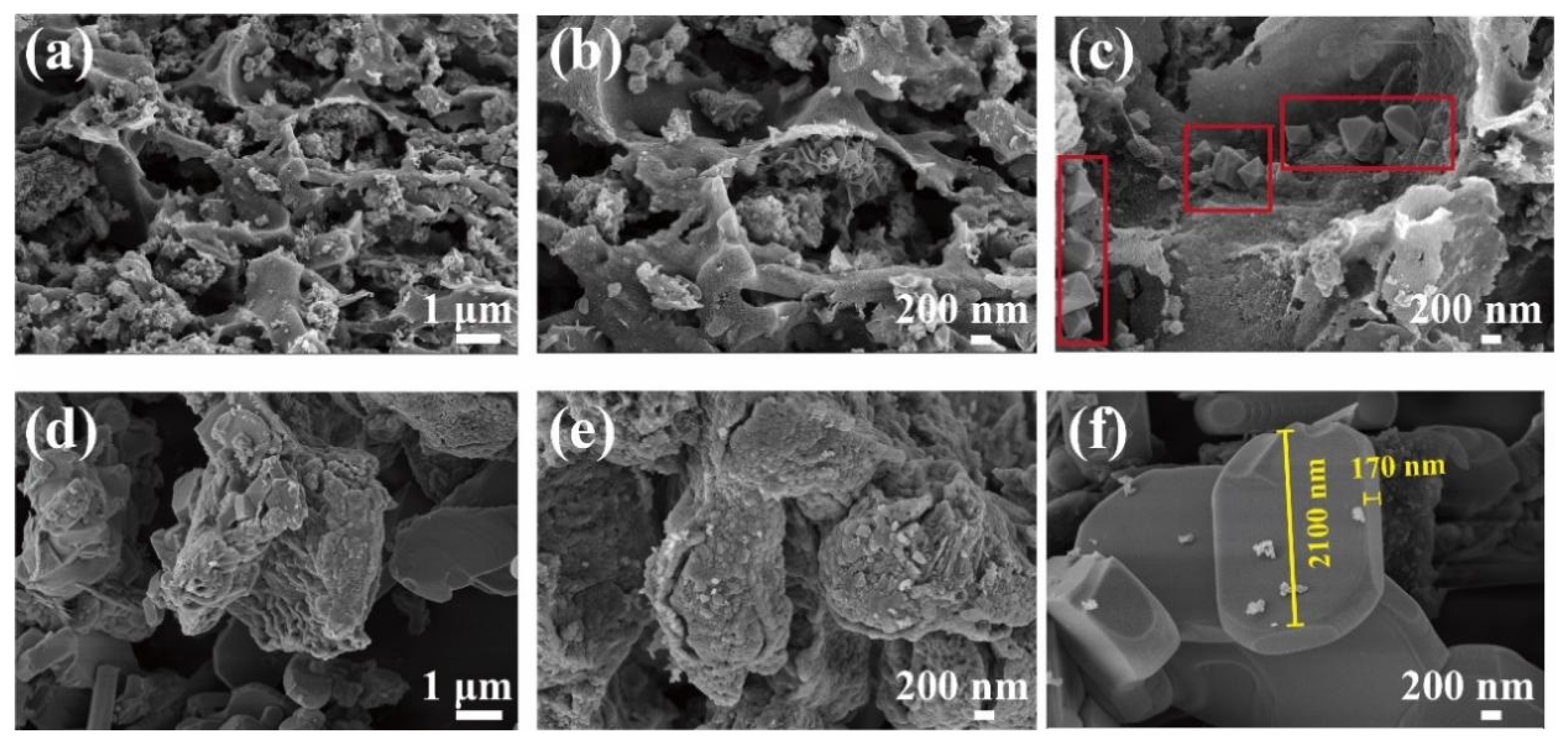

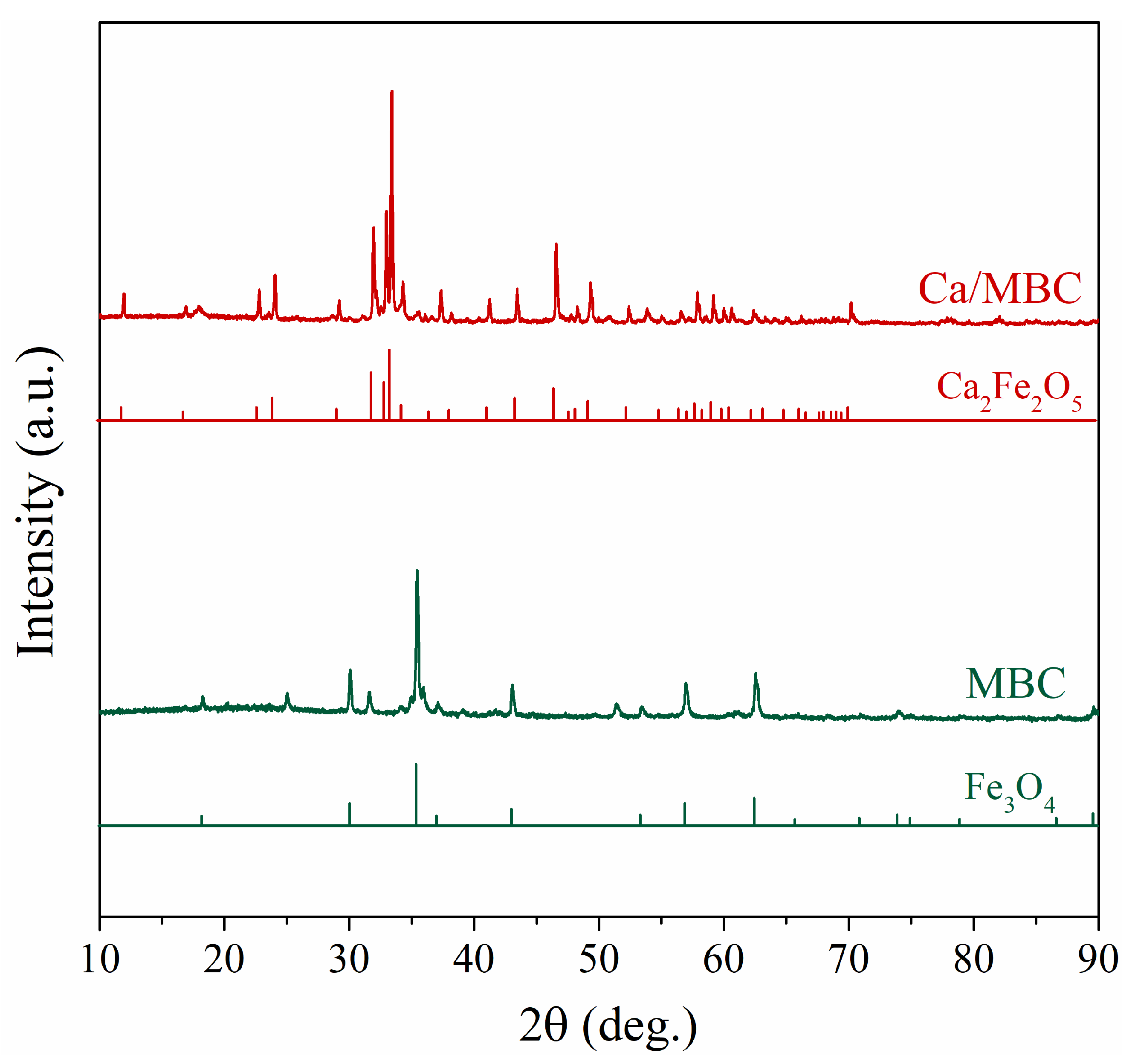
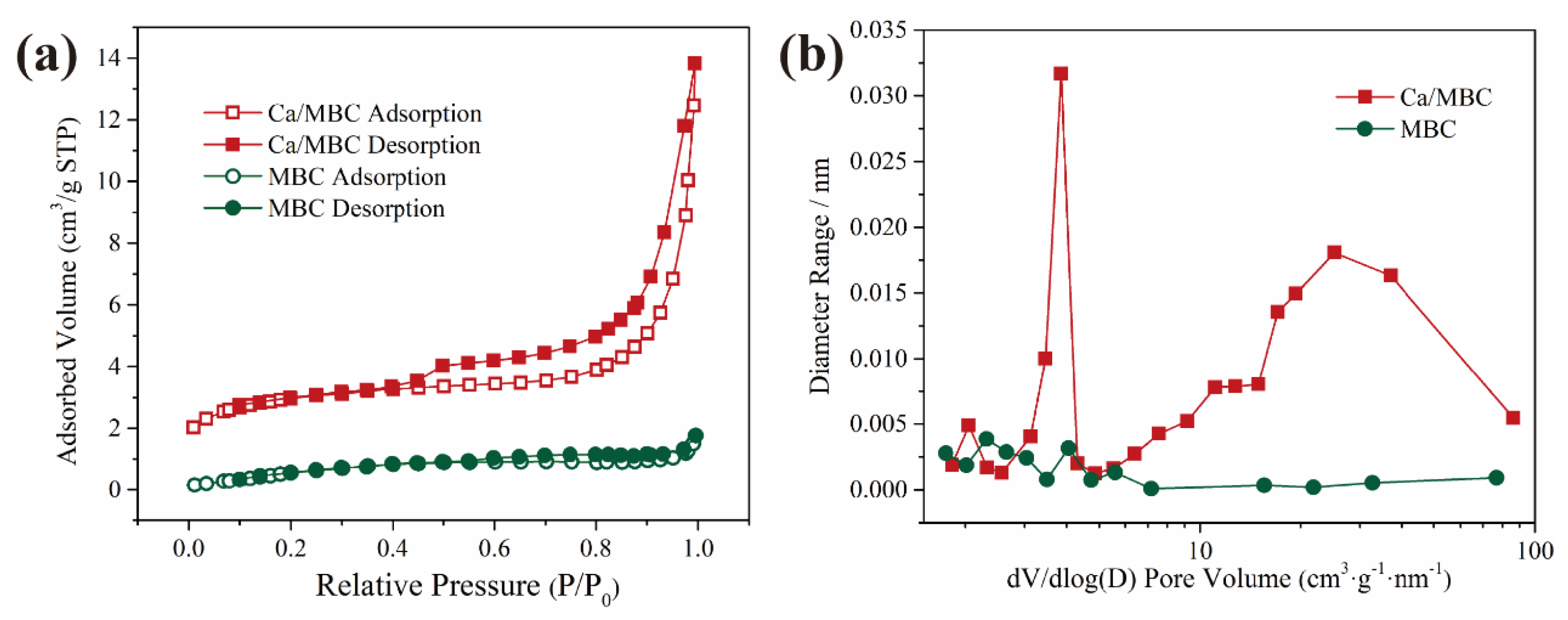
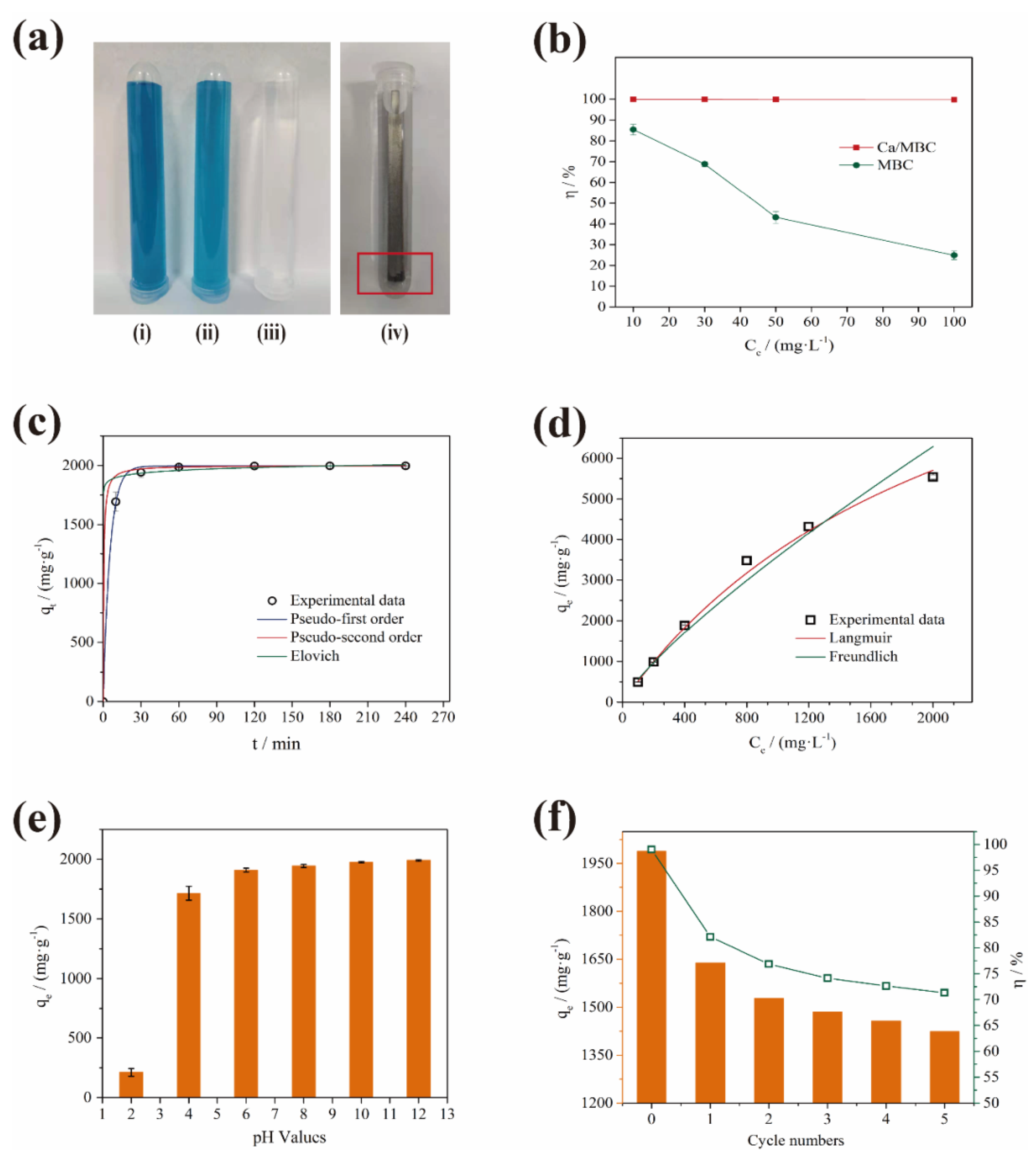
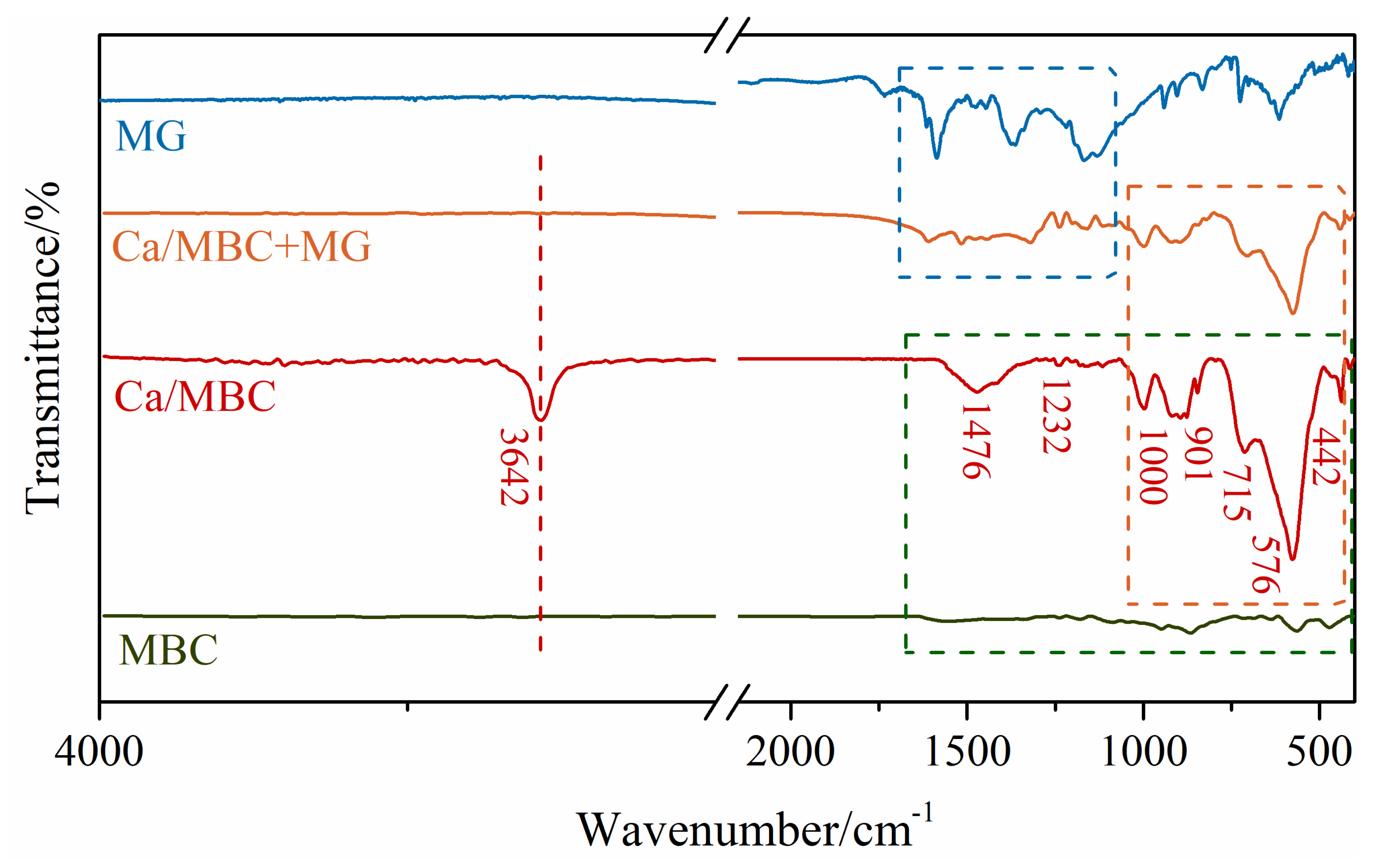
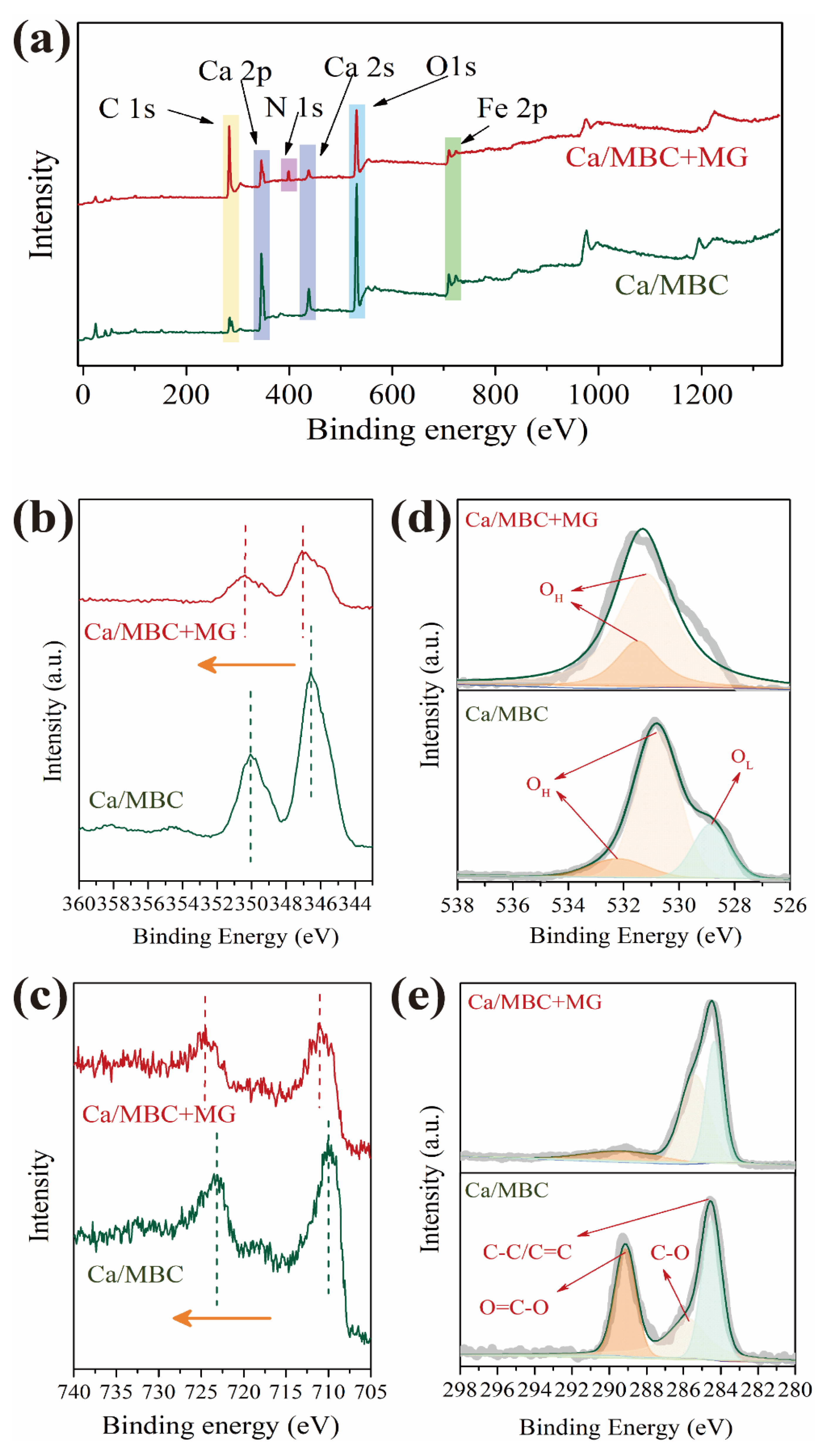
| Adsorbents | Adsorption Mechanisms | Adsorption Capacity | Ref. |
|---|---|---|---|
| Litchi peel biochar | Hydrogen bonding P-p interaction Pore filling Electrostatic interactions | 2468 mg/g | [16] |
| Activated wakame biochar material | Physical adsorption Chemical adsorption | 4066.96 mg/g | [9] |
| Kitchen waste mixed-base biochar | Physical adsorption Electrostatic Interaction Ion exchange Void filling | 7434 mg/g | [31] |
| Calcium-functionalized magnetic biochar | Electrostatic adsorption Ligand exchange Hydrogen bonding | 12,187.57 mg/g | This study |
Publisher’s Note: MDPI stays neutral with regard to jurisdictional claims in published maps and institutional affiliations. |
© 2022 by the authors. Licensee MDPI, Basel, Switzerland. This article is an open access article distributed under the terms and conditions of the Creative Commons Attribution (CC BY) license (https://creativecommons.org/licenses/by/4.0/).
Share and Cite
Wang, P.; Chen, W.; Zhang, R.; Xing, Y. Enhanced Removal of Malachite Green Using Calcium-Functionalized Magnetic Biochar. Int. J. Environ. Res. Public Health 2022, 19, 3247. https://doi.org/10.3390/ijerph19063247
Wang P, Chen W, Zhang R, Xing Y. Enhanced Removal of Malachite Green Using Calcium-Functionalized Magnetic Biochar. International Journal of Environmental Research and Public Health. 2022; 19(6):3247. https://doi.org/10.3390/ijerph19063247
Chicago/Turabian StyleWang, Pengjie, Wei Chen, Rui Zhang, and Yanfeng Xing. 2022. "Enhanced Removal of Malachite Green Using Calcium-Functionalized Magnetic Biochar" International Journal of Environmental Research and Public Health 19, no. 6: 3247. https://doi.org/10.3390/ijerph19063247
APA StyleWang, P., Chen, W., Zhang, R., & Xing, Y. (2022). Enhanced Removal of Malachite Green Using Calcium-Functionalized Magnetic Biochar. International Journal of Environmental Research and Public Health, 19(6), 3247. https://doi.org/10.3390/ijerph19063247





